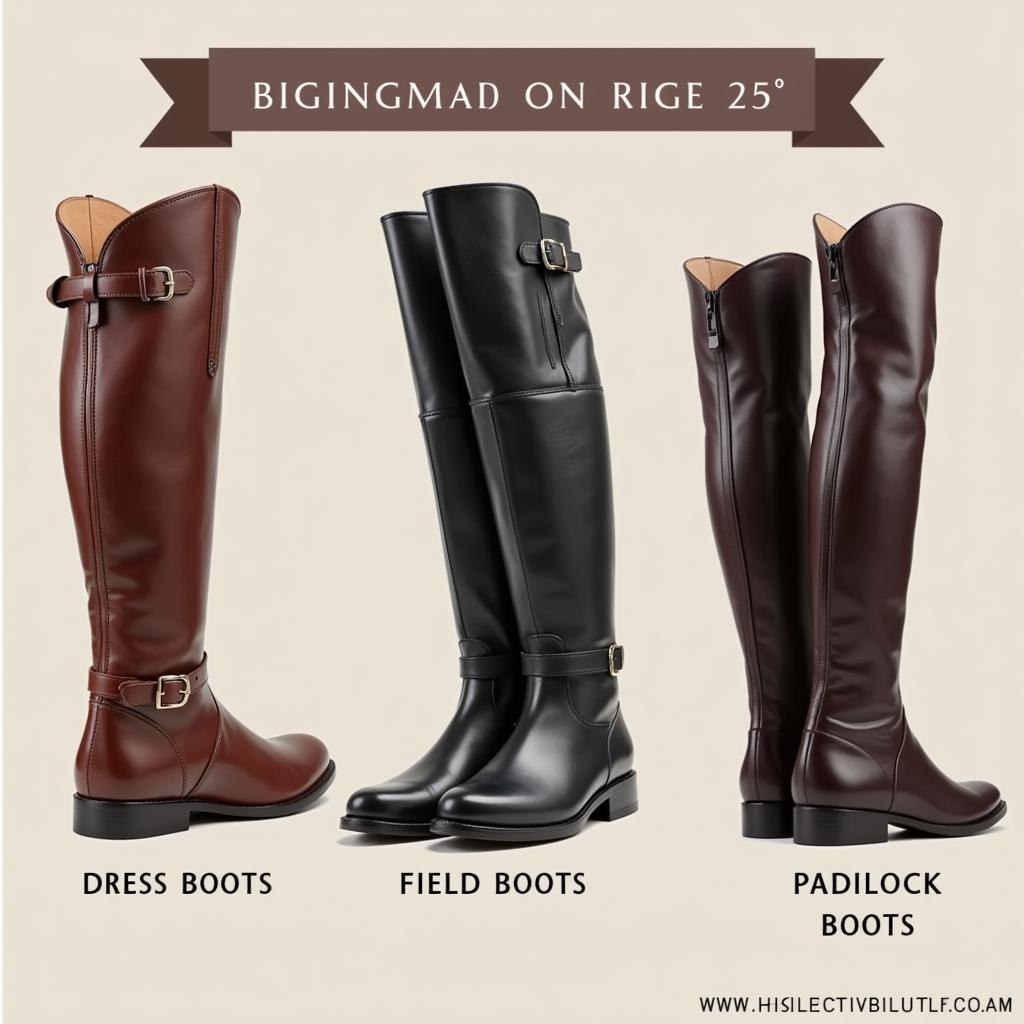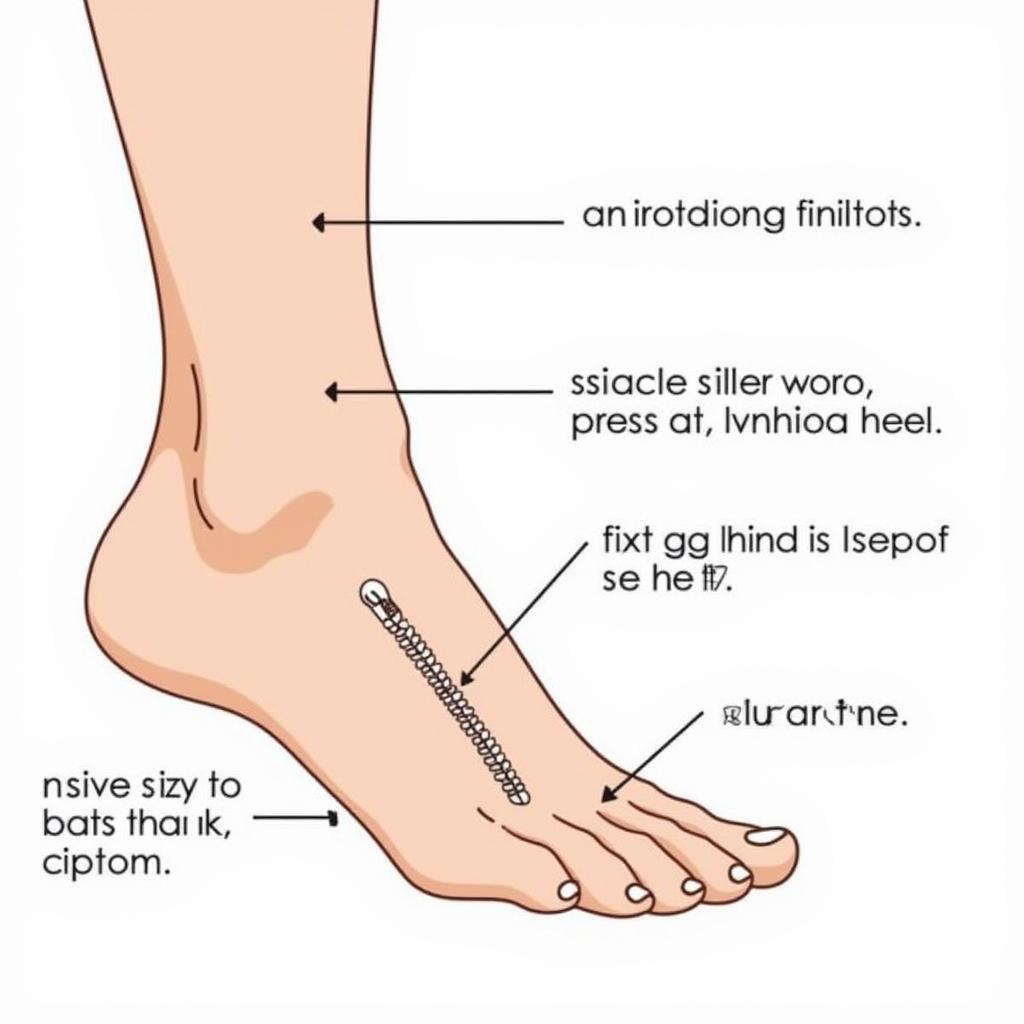Riding boots are an essential piece of equipment for any equestrian. They provide support, protection, and comfort while you’re in the saddle, whether you’re a seasoned competitor or a casual rider. With so many different styles and brands available, finding the right pair of Riding Boots For Horses can feel overwhelming. This comprehensive guide will walk you through everything you need to know to make an informed decision.
 Different Styles of Riding Boots
Different Styles of Riding Boots
Understanding the Importance of Proper Riding Boots
Before we dive into the specifics of choosing the right boots, let’s first understand why investing in quality footwear is crucial for horse riding:
- Safety: Riding boots protect your legs from chafing against the saddle and stirrups, and they provide crucial ankle support in case of a fall.
- Comfort: Proper riding boots offer comfort and stability, allowing you to focus on your riding and communication with your horse.
- Performance: The right boots can enhance your riding experience by providing a secure grip and allowing for precise leg aids.
 Key Features of Riding Boots
Key Features of Riding Boots
Types of Riding Boots for Horses
There are three main types of riding boots for horses, each designed for specific disciplines and riding styles:
1. Dress Boots
As the name suggests, dress boots are typically worn for competitions and formal riding events. They have a tall, elegant design that reaches just below the knee and features a sleek, polished look.
- Key Features:
- Tall, sleek design with a high shaft
- Minimal lacing or buckles
- Often made from smooth leather
- Designed for a polished and formal appearance
2. Field Boots
Field boots are versatile boots suitable for a wide range of riding disciplines, from jumping to eventing. They offer a balance of flexibility and support, making them ideal for riders who engage in multiple equestrian activities.
- Key Features:
- Tall shaft that reaches below the knee
- Lacing along the ankle for a customizable fit
- Sturdy construction with a reinforced toe and heel
- Suitable for both training and competition
 Equestrian Wearing Field Boots While Jumping
Equestrian Wearing Field Boots While Jumping
3. Paddock Boots
Paddock boots are short riding boots that stop just above the ankle. They are popular among riders of all levels, especially for everyday riding, lessons, and working around the stable.
- Key Features:
- Short shaft that ends above the ankle
- Durable construction for everyday wear
- Often paired with half chaps for additional leg protection
- Available in various materials like leather and synthetic fabrics
Factors to Consider When Choosing Riding Boots for Horses
Now that you’re familiar with the different types of riding boots, let’s explore the key factors to consider when making your selection:
1. Riding Discipline and Style
The type of riding you do plays a significant role in determining the most suitable boot style. For instance, dress boots are ideal for dressage, while field boots are more versatile for jumping and eventing. If you’re primarily a casual rider, paddock boots might be a practical choice.
2. Foot and Calf Size
Proper fit is crucial for both comfort and safety. When choosing riding boots, make sure to measure both your foot length and calf circumference accurately. If you have wider calves or need extra room for custom orthotics, consider boots with adjustable features like laces or zippers.
“A well-fitting riding boot should feel snug but not restrictive,” says Jane Miller, a certified riding instructor and boot fitter. “It’s important to have enough room in the toe box to wiggle your toes and avoid discomfort during long rides.”
3. Material and Durability
Riding boots are available in various materials, with leather being the most traditional and durable option. Leather boots offer excellent breathability and mold to the shape of your foot over time, providing a custom fit. Synthetic materials are becoming increasingly popular due to their affordability and easy-care nature.
4. Budget and Brand Reputation
Riding boots can range in price from affordable to high-end depending on the brand, materials, and features. It’s essential to set a budget beforehand and research different brands to find a balance between quality and price.
Conclusion
Choosing the right riding boots for horses is a personal decision that depends on your individual needs and preferences. By understanding the different types of boots available, considering key factors like riding discipline and fit, and investing in quality footwear, you can enhance your riding experience and ensure both your comfort and safety in the saddle. Remember, your boots are an extension of yourself when you’re on horseback, so choose wisely and enjoy the ride!
FAQs About Riding Boots for Horses
1. How often should I clean my riding boots?
Clean your riding boots after each use to prevent dirt and sweat from damaging the material. Use a damp cloth and saddle soap for leather boots, and follow the manufacturer’s instructions for synthetic boots.
2. Can I wear my regular shoes for horse riding?
It’s not recommended to wear regular shoes for horse riding as they lack the necessary support and safety features of riding boots. Regular shoes can easily slip out of stirrups, increasing the risk of accidents.
3. What’s the difference between half chaps and full chaps?
Half chaps are worn with paddock boots and cover the lower leg from the ankle to the knee, providing additional protection and a more polished look. Full chaps, on the other hand, cover the entire leg from the ankle to the hip and are typically worn with paddock boots for added warmth and protection in colder weather.
4. Do I need special boots for different riding disciplines?
While certain boot styles are traditionally associated with specific disciplines, the most important factor is finding boots that offer the right fit, support, and functionality for your chosen riding style.
5. How long do riding boots typically last?
The lifespan of riding boots depends on the quality, materials, frequency of use, and care. With proper maintenance, leather riding boots can last for several years, while synthetic boots may have a shorter lifespan.
Still have questions?
Check out these helpful resources:
Need personalized advice? Contact our expert team at 0772127271, email us at [email protected] or visit us at QGM2+WX2, Vị Trung, Vị Thuỷ, Hậu Giang, Việt Nam. We’re here to assist you 24/7!